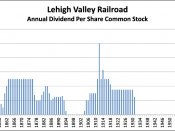TABLE OF CONTENTSINTRODUCTION3PERFORMANCE OF AVON'S STOCK FROM 1978-19883EVALUATION OF AVON' S FINANCIAL CONDITION IN MID-19885PURPOSE OF THE EXCHANGE OFFER6EVALUATION OF THE TRADE-OFF7REFERENCES10INTRODUCTIONA firm's decisions about dividends are often mixed up with other financing and investment decisions. Some firms pay low dividends because management is optimistic about the firm's future and wishes to retain earnings for expansion. Other firms might finance capital expenditures largely by borrowing. All the above are examples of dividend policies which can be defined more precisely as the trade-off between retaining earnings on the one hand and paying out cash and issuing new shares on the other. In order to understand the dividend policy we must understand that this phrase means different things to different people (R.A. Brealey & S.C. Myers, 2003).
Avon Products, Inc. announced both a change in its business focus and a reduction of its dividend in June 1988. To offset the likely stock price effect of the dividend reduction, Avon announced at the same time an unusual exchange offer under which it would take up to 25% of its common stock.
The case traces the history of Avon from 1979-88. We will evaluate Avon's efforts at diversification in the early 1980s, and will relate that effort to the company's dividend history. Moreover we will evaluate Avon's operating and financial strategies from 1979 to 1988 and the company's financial condition in mid-1988.
PERFORMANCE OF AVON'S STOCK FROM 1978-1988Based on Exhibit 4, Avon's stock price has declined from $50.75 in 1978 to $24.125 in 1988 (decline equal to 52.5%). At the same time, S&P 500 has increased from $96.11 in 1978 to $266.69 in 1988 (increase equal to 177.5%). This rather poor performance of Avon stock contradicts with the performance of the overall market. Moreover, based on Exhibit 1, ROE decreased from 31% in 1978...


